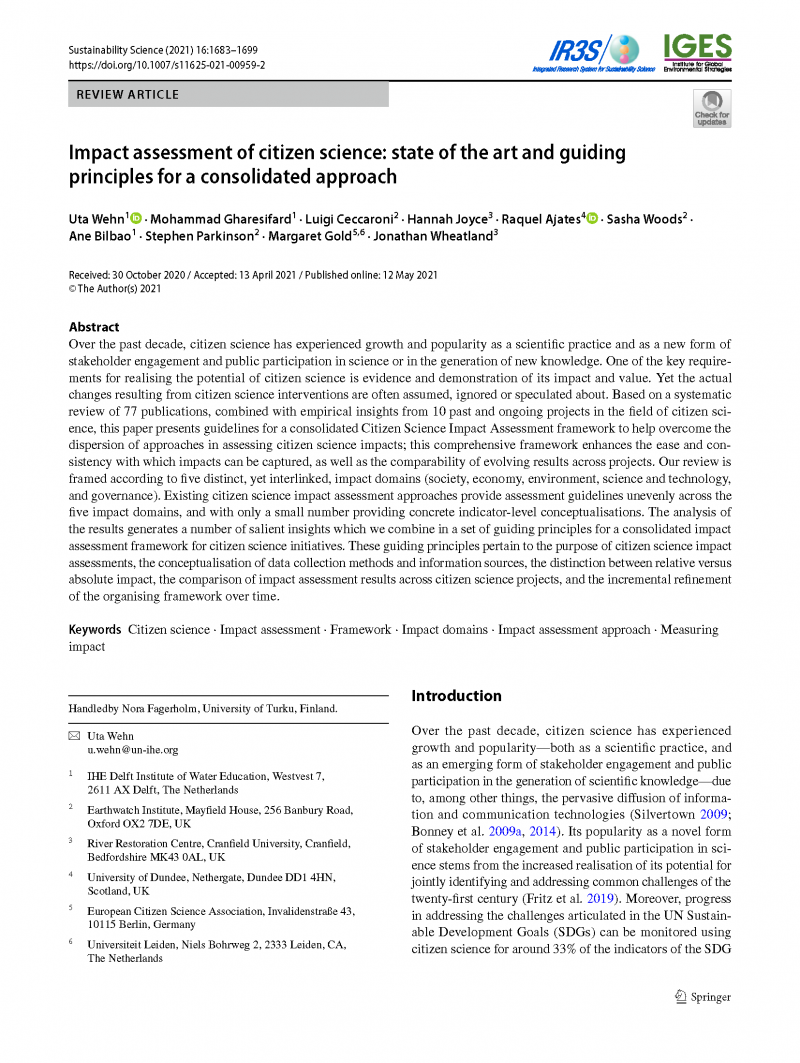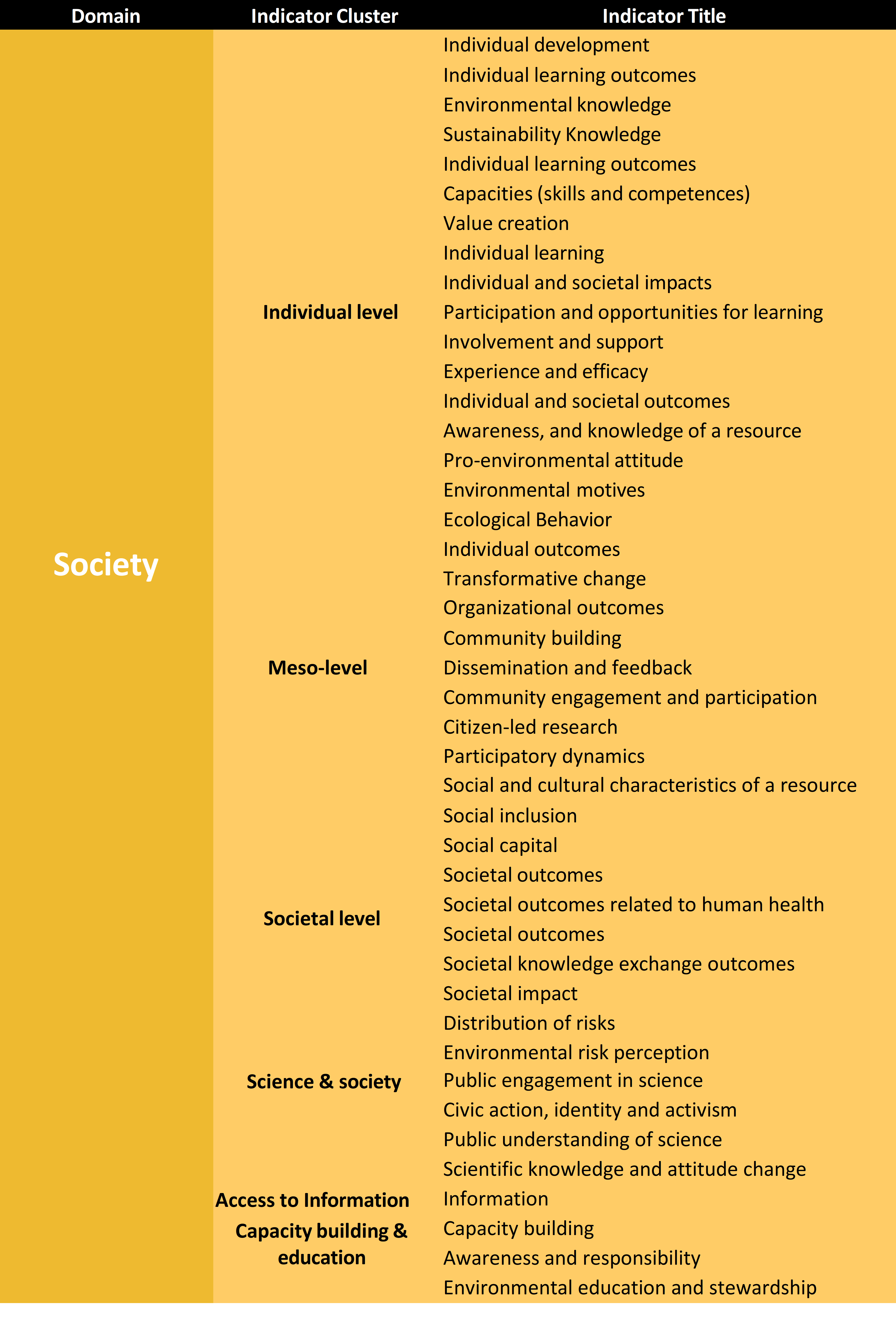I want to measure the impacts of citizen science projects
...by focusing on specific indicators using the
MICS Impact Indicator Explorer
...by focusing on specific indicators using the
MICS Impact Indicator Explorer
Why is it relevant?
In order to measure the wide range of impacts associated with citizen science, or to focus on one specific impact, you need clear, measurable impact indicators. For example, you may only be interested in identifying the effect of your citizen science initiative on ecosystem resilience, gender equality, or employment. By examining these indicators in detail, you can obtain a granular understanding of citizen science impacts and you can use resources efficiently.
This approach provides a range of benefits. Firstly, it allows you to use state of the art tools or assessment methodologies that are tailored to measuring specific indicators. Instead of 'reinventing the wheel' and developing new approaches to measuring indicators, you can save time and resources by using tried and tested approaches from other fields. For example, the field of environmental psychology has developed a range of approaches for the measurement of pro-environmental attitudes. These approaches can be easily used by citizen science practitioners.
In addition, due to its cross-disciplinary nature, the impacts of citizen science initiatives can range significantly. While some initiatives may focus on environmental improvements, others may aim to influence governance structures. This means that indicators that are very relevant for some initiatives may be less relevant for others. By selecting only relevant indicators, you can maximise the time you spend monitoring the indicators which are most important to you.
Furthermore, as with other approaches to impact assessment, by identifying indicators and appropriate methods for their measurement, a common approach to impact assessment can be built. Without a common and shared approach to impact assessment, comparability across citizen science initiatives remains difficult. Without comparability, we are unable to learn which approaches are most beneficial across citizen science initiatives. By building a common set of tools to measure specific indicators, comparison of impacts can occur at an even finer level.
How can this be done?
You can use the MICS Impact Indicator Explorer to select relevant indicators for measuring the impacts of your citizen science initiative.
The indicators are grouped into five domains:
- Society - Impact on society and individuals, as well as collective (societal) values, understanding, actions and well-being (including relationships).
- Economy - Impact on the production and exchange of goods and services among economic agents; on entrepreneurial activity; economic benefits derived from data, e.g., for the public good or for the benefit of private sector actors.
- Environment - Impact on the bio-chemical-physical environment, e.g., on the quality or quantity of specific natural resources or ecosystems.
- Science and technology - Impact on the scientific process (method) as well as research more broadly; on the scientific system (institutions; science policy; incentive structures), scientific paradigms and resulting technological artefacts (e.g., sensors, apps, platforms) and standards.
- Governance - Impact on the processes and institutions through which decisions are made, both informal and formal (e.g., public policy), and on relationships/partnerships, as well as the governance of data generated.
Useful Resources
PAPER: The paper Impact assessment of citizen science: state of the art and guiding principles for a consolidated approach provides a detailed outline of the MICS conceptual framework, as well as insight into the development of the inventory of the indicators.
WEBSITE: The EU-Citizen.Science project hosts an inventory of citizen science projects on their website, with a subsection which focus on impact within citizen science.
WEBINAR: During the second version of the EU-Citizen.Science workroom in 2021, a variety of citizen science impact assessment frameworks were presented, including that of MICS
WORKSHOP: During 2020 ECSA Conference a workshop was held on the evaluation in citizen science, focusing on the role of citizens in evaluation
TOOL: The Community Level Indicators Tool is open source and has been developed with community-led citizen science projects in mind. It is part of Citizen Sensing: A Toolkit, a collection of 25 methods and tools that can be used in citizen science projects.
TOOL: ACTION has developed an impact assessment framework and methodology to help citizen science projects understand what scientific, social, economic and political impact they have.
WEBSITE: The Co-Act project largely focuses on the social impact of citizen science initiatives for groups sharing a social concern, and has developed a toolkit allowing for evaluation of these projects
You may also be interested in:
I want to measure the impacts of citizen science projects...
...by using a standardised approach
MICS Impact Indicator Explorer
You can explore suitable indicators in each domain and sub-domain via the links below:
MICS Consolidated Impact Assessment Framework
As part of the MICS project, a conceptual framework of citizen science impacts and indicators was developed. This framework aimed to consolidate the previously dispersed approaches to impact assessment within citizen science by detailing the broad range of indicators impacted by initiatives, and state of the art impact assessment approaches for each.
Based on a systematic literature review (Wehn et al. 2021), the framework highlighted five interlinked domains of impact and, within these five domains, a variety of sub-domains were identified with specific indicators.
For each indicator, a concrete approach for its measurement has been identified. These approaches form the state of the art for the measurement of that specific indicator, taken from its respective field. When it comes to measuring impacts across these fields, practitioners are often not familiar with the current state of the art, particularly concerning impact assessment approaches. This framework provides a detailed list of these approaches, allowing citizen science practitioners to pick specific measures or tools to measure their indicator of choice.
The conceptual framework presents a complete overview of possible citizen science impacts, and details methodologies that can be used to measure these impacts. The resulting inventory has been made available here as the MICS Impact Indicator Explorer.

Wehn, U., Gharesifard, M., Ceccaroni, L., Joyce, H., Ajates, R., Woods, S., Bilbao, A., Parkinson, S., Gold, M. and Wheatland, J. (2021) Impact assessment of citizen science: state of the art and guiding principles for a consolidated approach. Sustainability Science, 16(5), pp.1683-1699.





